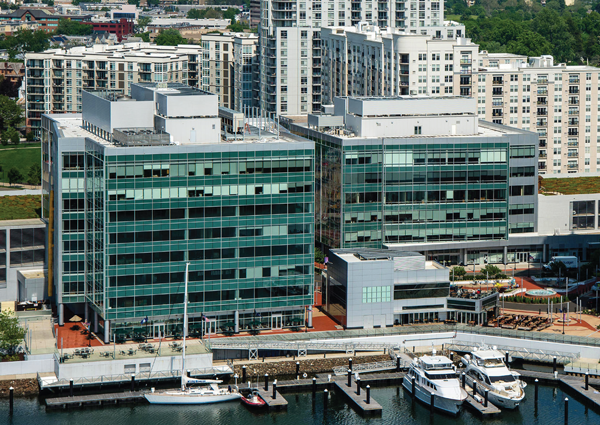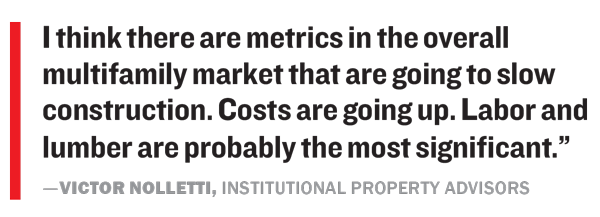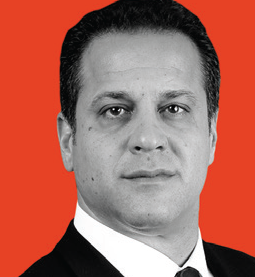Trending
Fairfield County’s hottest commodity
Thousands of new rental units are getting snapped up the moment they’re available, but can the multifamily building</br> bonanza last?

In the last few years, thousands of rental units have come online in Fairfield County’s cities, and thousands more are under construction. Even when the region’s office market stumbled, Stamford, Norwalk and Danbury — the urban centers of Connecticut’s Gold Coast — saw a boom in multifamily development. In Stamford’s Harbor Point complex, for example 2,360 apartments have been built and more than 1,000 are still under construction.
And there’s plenty of demand to meet that rising supply. The population of Stamford increased 5.5 percent from 2010 to 2016, according to U.S. Census data. While much of the focus is on attracting millennial renters, older empty nesters in Fairfield County have also been downsizing, drawn to the freedom of a residence that doesn’t require maintenance, many sources said.
Both the millennials and empty nesters are feeling the pull of new construction and luxurious building amenities that are offered without the fuss of maintaining a freestanding single-family home. Apartment dwellers can choose from a wide range of features: a gym, rooftop deck and a concierge at their beck and call.
And all of it is available for quite a bit less than anything available in New York City. The median rent for a one-bedroom in New York City was $3,500 in June, whereas the median for a one-bedroom rental in Stamford was $1,550 in the same month, according to real estate listings site Trulia.
As the multifamily boom rolls on, these suburban cities are seeing something nearly unheard of in Fairfield County previously: nightlife options. New restaurants and bars are opening up in these edge cities where the downtown area traditionally emptied out at 5 p.m. as workers drove back to their suburban houses. Downtown Stamford now hosts an evening outdoor concert series for local officer workers, returning commuters and local residents who want to enjoy the live-work-play lifestyle right in town.
Some experts say that the increasing population is helping to attract businesses back to a state that has seen GE, Aetna and UBS move away. Job search giant Indeed announced this summer that it intends to bring hundreds more jobs to Stamford, and consumer goods company Henkel is expanding too.
But some residents have begun asking how much development is too much. With so much new building, the older infrastructure is being tested. Car traffic — long the bane of rush-hour commuters in and out of New York — is only getting worse, and it now ensnares even residents trying to get from one town to the next.
The New Haven line, the Metro-North artery that connects Connecticut’s suburbs to Manhattan, recorded 40.5 million rides in 2016, about 20,000 more than the year before.
In the long term, Gov. Dannel Malloy has proposed adding an additional lane in each direction on I-95 and instituting a congestion pricing plan, as well as adding more tracks for Metro-North’s trains.
Still, transit headaches haven’t kept new residents away thus far. To further investigate the issue, The Real Deal asked a group of industry insiders why Fairfield County’s apartment rental market is booming, if it will continue — and what it all means for the future.

Ted Ferrarone
Ted Ferrarone
Chief operating officer, Building and Land Technology
As a commercial real estate firm, are you concerned about rental housing hitting a saturation point in Stamford?
There’s certainly been a lot of growth in the city. When we started developing in Stamford, the city’s master plan indicated that they thought there was demand for another 10,000 units, and there hasn’t been anything like that in terms of development. As we built out Harbor Point, we found the next building isn’t really competitive with the first building. It’s more complementary because it provides a different product [in terms of size and amenities].
How do the multifamily developments fit in with the leafy image of the suburbs?
I think they’re actually complementary. After a couple years, a lot of those people [who rent] end up moving out of their apartment, and they’re buying single-family homes. It’s really the feeder population for single-family homes. What’s interesting now is that we’re seeing, at the other end of the life cycle, the people in those single-family homes on the quiet streets are selling their houses and moving into apartments.
Who are you trying to attract to your projects?
We’ve certainly tried to create a diversity of product throughout the market. We’ve built buildings with intentionally smaller units to provide a lower price point for younger people who are just coming out of school. And we’ve built buildings we thought would cater to empty nesters who are looking for bigger units with more storage space and amenities.
What amenities are featured in these projects?
You will see highly amenitized buildings. You see that nationally. There’s two sets: one is the amenities right in the building, and the second is the amenities near your building within walking distance. In the units themselves, there’s a great diversity of options. If you want a giant walk-in closet, you’ll find it.
Have struggles in the office market had an impact on development?
It’s true that there’s a high office vacancy rate in Stamford, but if you look at the statistics, the average income in Stamford has grown steadily from 2010 to 2016. The population has grown from 2010 to 2016. Employment has grown from 2010 to 2016. So, there’s more people working here than ever before, and they’re making more money. Would I love to see 10 more companies employing a thousand people come here? Of course, but it’s not as if we’re struggling. There’s no one employer that employs a huge percentage of the residents. If one company moves, it’s not great, but it doesn’t necessarily have a great impact on your occupancy.

Joseph McGee
Joseph McGee
Vice president, Business Council of Fairfield County
What is it about Fairfield County that’s drawing so many apartment dwellers now?
I think it reflects a change demographically. Younger people are really returning to the cities, and we see that in Stamford. The other addition is empty nesters; those whose kids have now grown up now are looking at large houses and saying, “You know, I don’t want to mow the lawn.”
How does the rental market fit in a traditional suburban market?
What has happened here in the last 15 years is the rebuilding of Norwalk and Stamford around a different lifestyle. If you look in Norwalk right now, it’s incredible to see the apartments that are all built along Main Street, down near where the turnpike is. They’re all full. Stamford is a different town now, and these units seem to be 95 percent full. We keep seeing new buildings going up and wondering if there’s going to be people to fill them, and then they’re filled.
How has the apartment boom changed the area?
Twenty years ago, at 5 o’clock, the office buildings emptied out and everybody went home. You could roll a bowling ball down Main Street here. Today, there’s an active life. So these towns like Stamford, Norwalk and Danbury, they were centers of employment 25 or 30 years ago, but they really did not have a livable environment, and that’s now changing. We now have 10,000 people living in downtown [Stamford] and another 5,000 in the South End. These people did not exist here 20 years ago.
Does the overall growth continue?
I think this growth process continues. About six months ago, we saw interest from companies looking to come into Stamford, but it wasn’t showing up in the employment numbers yet. This month, we see that Connecticut has restored all the jobs that they lost during the Great Recession, and that fits. Our job growth statewide is about 5,000 to 6,000 jobs a month, which is a lot for us historically.
Can the transportation infrastructure handle all the growth?
That’s the critical question. We’ve been meeting with New York City’s Department of City Planning on this very issue. We are really proposing a regional compact with New York City, the Bronx, Fairfield and Westchester counties to look at the capacity of the Metro-North New Haven line. What we’re saying is we need to increase the speed and frequency of the New Haven line. New York is looking at widening I-95 in the Bronx, Connecticut is looking at widening I-95. But there’s no way we’re going to widen 95. So, I think the highway strategy has limited viability. The rail strategy and rapid bus service are really our future.
What is the overall economic situation?
We got hit very hard in Connecticut with the recession, but we finally seem like we’re out of it — growing jobs again, and our population is beginning to increase again slowly. I think what happened during the recession is that we’re kind of changing the built environment here, in which cities will be centers of more dense urban-style housing with all the amenities, built around train stations and things like that.
What do the apartments offer potential renters that they couldn’t get elsewhere?
It’s quality of life. We never had a building in Stamford where you could have a dog; now we have a building exclusively for dog owners. You can walk almost everywhere. They have a trolley that picks you up and takes you to the train station. That’s what’s driving this. I think what we’re seeing in Connecticut are trends that we see in Brooklyn and Jersey City, and that is a revitalization of urban life. It’s exciting. And that’s also driven by safety. Stamford is now one of the safest small cities in America.

Bruce Berg
Bruce Berg
Executive vice president, The Cappelli Organization
What is drawing so much development to Stamford?
Stamford is becoming more of a 24/7 city. There’s so much to do now. The more residential development they build, the more social development there is. There’s the new Chelsea Piers [sports complex]. The city is putting money into Mill River Park. UConn built their campus in Stamford a couple years ago. Stamford is really a very attractive city outside of New York.
What does the future of the market look like in Fairfield County?
It looks strong. Every time inventory comes on the market, it gets snapped up. We still have the second stage to go on our Atlantic Station project, and we’re redeveloping the old Post Office too.
What do you think attracts millennial tenants?
We’re going to have full indoor parking for every resident, plus a 24-hour concierge. We’re building the nicest roof deck in the county — with views of all the surrounding towns — with fire pits, barbecues and all the amenities you could want. There are going to be condo-level finishes in all the apartments, stone countertops and imported cabinets.

Dave Campana
Dave Campana
Halstead Realty, Stamford office
Why are rentals so hot in Fairfield County now, as opposed to single-family homes?
It’s a trend overall in all the markets that people are looking more for convenience. Listen, builders build. And the banks are throwing money at anybody developing multifamily properties [in Fairfield], so that’s why there’s such a boom. There are 650 units on Atlantic Street [in Stamford]; you got another 650 units that are supposed to go where “the hole in the ground” is. It goes on and on.
What does that mean for the future?
At some point, that market will turn, and then what will happen is — and we’ve seen it before — there will be a glut of condos for sale, because some of these buildings will have to switch over and sell them off as condos. Everything is filling up quickly, but soon that will turn. So when it does turn, the single-family home market will be less affected because there’s no land in Stamford [to build more single-family homes]. Whatever inventory of single-family homes there are is what there is.
Can the area handle so much development?
In the end, it’s good for Stamford because it allows for population growth, which was going to happen anyway. But I do think it has put a very hard stress on the infrastructure because it happened so quickly. The city hasn’t had time to keep up. That should have been part of the development — that they had these developers build out the infrastructure to support these buildings, which they didn’t do.

What about the traffic?
More people want to live in these areas because it’s where the jobs are. Years ago, you were able to go to Trumbull or other areas that were a little less expensive and then commute to Stamford. But that drive now … forget it. You either leave at 5 in the morning and [return] at 8 at night, or you’re just going to sit on the highway.
What is attracting people to these kinds of buildings?
Obviously it’s the proximity to restaurants and bars, the gym and gathering spaces. Those kind of amenities are always attractive to the younger people. It all comes down to the ease of living: You lock your door and you’re done. It’s all taken care of by the landlord. But at the end of the day, you’re paying for it, because these rents are not inexpensive.
How do rentals impact home sales?
I think at the end of the day, the rental market has been strong, but it will also lead to a strong sales market because these people will realize that you just can’t keep renting and throwing away that kind of income.

Victor Nolletti
Victor Nolletti
Executive director, Institutional Property Advisors
What does the future look like for developers in Fairfield County?
I think there are metrics in the overall multifamily market that are going to slow construction. Costs are going up. Labor and lumber are probably the most significant. And financing has, on both the primary financing and the equity tier, become a little bit conservative, I think. So couple increased construction costs with some minor shifts in the financing environment, and that’s probably going to organically slow down the supply chain.
Do you have any worries about the job market?
In spite of all the optics we see, there are jobs, and they’re growing in Stamford. There are a lot of positive drivers in the state of Connecticut in spite of our budget woes. UBS exited, which is not great, but meanwhile, we continue to absorb apartments in Stamford at a seasonally adjusted pace of 20 to 30 units a month.
Why are people choosing Fairfield?
They could be moving to Westchester County, but I think Stamford is much more desirable than White Plains and some of the comparable Westchester County locations. For quality of life: the shoreline, it’s new, it’s crisp, it’s highly walkable.
What kind of amenities are the renters looking for?
All these jobs are fully amenitized — they’re creating a lifestyle experience. [There are] fitness rooms, media rooms, golf simulators, roof decks, fire pits, outdoor TVs, and some are doing pools. Pet wash stations — that’s a big amenity. A good segment of the renter pool has pets, and they value them. They’re family.
Do all the new apartments change the character of Fairfield County?
What it does is it gives the home owner access to a more vibrant city should they choose to exploit it. So you can live on three acres of land and in 15 minutes be in the center of Stamford and park your car and walk to any number of shopping destinations, restaurants or bars. The continued growth in the Stamford multifamily market enhances certain suburban markets that have access to it.




